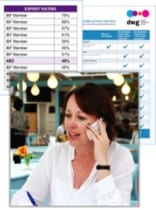Six things the Digital Workplace Group has learnt about digital workplace maturity

One of the fascinating things about an emergent theme such as the digital workplace is that we’re all still collectively learning. Organizations and teams are continually trying out new approaches, or applying innovative twists to more established practices around designing, delivering and managing the digital workplace.
This is a very exciting field to be in and we love hearing about what our members, clients and friends have been implementing, to add to our body of knowledge about the digital workplace. Whenever we can, we record and absorb these findings into our research programme.
The Power of Data
Since we launched our new service offering, the Digital Workplace Maturity Benchmark, we’ve been able to start collecting data across different organizations about the maturity of their respective digital workplaces.
Getting independent and comparable metrics across different organizations about the digital workplace is like gold dust – and we’ve started to notice some early trends, which we’ve detailed in our new free downloadable research report “How mature is your digital workplace?”
What is the Digital Workplace Maturity Benchmark?
After more than a decade of pioneering the benchmarking of intranets for large organizations, and also establishing the company as a global thought leader in the area of digital workplaces, DWG has synthesized our best practices and approaches into a service for benchmarking the maturity of digital workplaces. Uniquely, we provide an independent, consistent and holistic evaluation of the digital workplace across seven different elements, covering:
- Communication and Business Intelligence
- Collaboration and Community
- Services and Workflow
- Structure and Coherence
- Mobility and Flexibility
- Strategic Alignment and Management
- Organizational Readiness
From comparing the performance of a number of digital workplace maturity benchmarks, here are six observations so far
- Early adopters are measuring the digital workplace
Many organizations are only just starting to think about the digital workplace, although some have already built structures, programmes and initiatives around the concept. So far, all the organizations that have carried out a benchmark have demonstrated mid to high levels of maturity for their digital workplaces. This hints that those organizations who have already made some progress are interested in measurement, particularly where it encompasses a more holistic view of the entire digital ecosystem and application portfolio.
- Achieving a true digital workplace is a long-term goal
In our benchmarks so far, even those organizations with higher levels of maturity still have a long way to go, with progress to be made; for example, only one organization has ever scored “Excel” (the highest level) in any of the seven dimensions of the benchmark model. This means there is still much progress to be made, even in organizations who have already moved forwards and can be regarded as early adopters. Overall, it’s still early days for the digital workplace.
- Organizations need to push the digital workplace up the strategic agenda
There is still significant development needed in the benchmark element of “Strategic Alignment and Management”. On the whole, the average score of benchmarked organizations for this is significantly lower than for most of the other elements. This is not surprising given that the digital workplace is a new concept. When looking at the detail within each benchmark, a familiar pattern starts to emerge. Although management practices and governance may be mature around certain key digital channels, such as the intranet or collaboration platform, more work in articulating and formalizing a strategy and vision across the wider digital workplace is required.
- Lack of investment in change management is constraining progress
The other element for which most organizations have scored significantly lower than in other parts of the benchmark model is “Organizational Readiness”. This element looks at how advanced practices are in enabling management and employees to use the digital workplace as a way of working. The low scores demonstrate that more investment in change management is needed in order to enable employees to use digital tools more effectively and to allow them to work more flexibly. There are also likely to be some cultural issues that may be holding organizations back.
- Collaboration and digital services are maturing in some organizations
Although patterns differ from organization to organization, the two elements where, collectively, the Digital Workplace Maturity Benchmark scored most highly are “Collaboration and Community” and “Services and Workflow”. This reflects that individual organizations have developed both maturity and experience in these fields; for example, some IT functions are adept at offering digital services to employees within a single sign-on environment. Meanwhile, the advancement of community management and other well-defined roles are helping to advance formal and more informal digital collaboration.
- Every organization’s digital workplace journey is unique
Although there are many common services across different organizations’ digital workplaces, actually each one tends to be unique. We’ve found that there is a different pattern for each Digital Workplace Maturity Benchmark participant. This is mainly down to different organizational characteristics, such as the organization’s culture or the composition of its workforce. These are significant influences on the evolution of a digital workplace.
How mature is your digital workplace?
Benchmarking the maturity of your digital workplace gives you an unparalleled holistic view of your digital workplace and is often the next step to either getting the digital workplace on the agenda, defining a strategy, delivering governance, planning a roadmap, or just charting your progress. Download our free research report for some insights into measuring digital workplace maturity.
Related Research and Resources
DWMB research
Arrange a call to learn more
Categorised in: → Digital workplace maturity, Research reports

